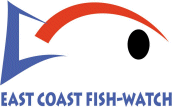

Conducted by

Sponsored by
EAST COAST FISH-WATCH PROJECT WORKSHEET No. 1
Since this worksheet was written in 1999 Fish-Watch members have sent in photographs documenting extensions to previously known fish distributions. This additional information is indicated below by the red font.
BUTTERFLYFISHES: FAMILY CHAETODONTIDAE
Butterflyfishes are common and conspicuous reef fishes at depths of 1-250 m in all tropical and warm temperate seas. Most species are associated with coral reefs, and coral polyps are common in the diet of some butterflyfishes. Other species feed on a variety of small benthic (bottom-living) invertebrates (worms, crustaceans, molluscs) and algae or zooplankton (small to microscopic pelagic animals that float or swim usually near the surface). The Latin genus name “Chaetodon” (pronounced ‘key-tow-don’) means “bristle tooth” and refers to the slender teeth of butterflyfishes. Most species are solitary or occur in pairs, but others form large aggregations. Their diurnal (active by day) habits and distinctive bright colours (featuring mainly yellow, white and black patterns) make them relatively easy for divers to identify. At night, most butterflyfishes usually change colour and retreat into crevices or caves to sleep.
The butterflyfish family comprises at least 123 species; 24 species occur off southern Africa. Twenty species are known from our east coast, and another four may be seen here. Species are numbered as in the book Smiths’ Sea Fishes (edited by M.M. Smith and P.C. Heemstra), first edition published in 1986 by Macmillan South Africa [now published by Southern Books].
SPECIES
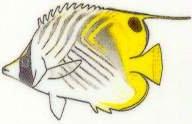 205.1 threadfin butterflyfish, Chaetodon
auriga Forsskål, 1775. Adults with front D rays elongated into a
filament; usually a black spot in D at base of filament; dark eye band
wider below eye than above. Feeds on coral, crustaceans, gastropods, worms
and algae. Does well in aquaria. Attains 20 cm. Red Sea and
Indo-Pacific to
205.1 threadfin butterflyfish, Chaetodon
auriga Forsskål, 1775. Adults with front D rays elongated into a
filament; usually a black spot in D at base of filament; dark eye band
wider below eye than above. Feeds on coral, crustaceans, gastropods, worms
and algae. Does well in aquaria. Attains 20 cm. Red Sea and
Indo-Pacific to Mossel Bay Aliwal Shoal, juveniles to Stilbaai, Western Cape .
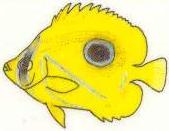 205.2 archer butterflyfish, Chaetodon bennetti Cuvier, 1831. Body mostly yellow; with 2 blue lines, 1 above and 1
below P base; black blotch (adults) or white-ringed ocellus (in juveniles) below
rear D spines; blue-edged dark bar through eye; C margin transparent.
Feeds exclusively on reef-forming coral polyps, difficult to keep in
aquaria. Attains 20 cm. Indo-Pacific south to
205.2 archer butterflyfish, Chaetodon bennetti Cuvier, 1831. Body mostly yellow; with 2 blue lines, 1 above and 1
below P base; black blotch (adults) or white-ringed ocellus (in juveniles) below
rear D spines; blue-edged dark bar through eye; C margin transparent.
Feeds exclusively on reef-forming coral polyps, difficult to keep in
aquaria. Attains 20 cm. Indo-Pacific south to Maputo Northern KZN, rare at Sodwana Bay.
205.3 brownburnie, Chaetodon blackburnii Desjardins, 1836. Body mostly dark brown with about 7 black (or
bluish-grey) stripes; head and front of body yellow; curved black band from D
origin through eye to underside of head; pelvic fins yellow; C hyaline
white. Attains 12 cm. Indian Ocean from Kenya to Bashee River
(Eastern Cape Province) and Mauritius, juveniles to Algoa Bay.
205.4 blackedged butterflyfish, Chaetodon dolosus Ahl, 1923. C yellow, peduncle and rear part of D & A blackish,
with white edge; dark eyebands joined at nape; juveniles pale olive green, with
vertical rows of small brownish spots; black blotch on middle D
rays. Attains 15 cm. Common at Aliwal, juveniles to Algoa Bay; also known from Mauritius and
Mozambique south to Xora River.
205.5 saddled butterflyfish, Chaetodon falcula Bloch, 1793. Body pale, with 2 triangular black blotches dorsally and
several vertical black lines; black band around peduncle and from nape through
eye to underside of head. Juveniles do well in aquaria. Attains 20
cm. Indian Ocean to Maputo.
205.6 gorgeous gussy, Chaetodon guttatissimus Bennett, 1823. Body pale, covered with small dark spots extending onto
D & A; dark band around C peduncle; black bar at middle of C. Feeds on
worms, algae and corals; wild-caught adults are difficult to feed in aquaria.
Attains 12 cm. Red Sea and Indian Ocean to Aliwal Shoal, juveniles to Algoa bay.
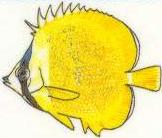 205.7 whitespotted butterflyfish, Chaetodon
kleinii Bloch, 1790. Body yellowish, with pale spot on each
scale; black band from D origin through eye to chest; soft D & A yellow,
with white edge and submarginal black line; rear margin of C transparent.
Feeds mainly on soft corals. Attains 13 cm. Red Sea and Indo-Pacific
south to Coffee Bay, juveniles to Stilbaai, Western Cape.
205.7 whitespotted butterflyfish, Chaetodon
kleinii Bloch, 1790. Body yellowish, with pale spot on each
scale; black band from D origin through eye to chest; soft D & A yellow,
with white edge and submarginal black line; rear margin of C transparent.
Feeds mainly on soft corals. Attains 13 cm. Red Sea and Indo-Pacific
south to Coffee Bay, juveniles to Stilbaai, Western Cape.
205.8 lined butterflyfish, Chaetodon
lineolatus Quoy & Gaimard, 1831. Body yellowish or white, with
about 16 vertical black lines; D, C & A yellow; adults with black band along
base of soft D to A base; black band enclosing white triangle above eyes.
Feeds on coral polyps and anemones. The largest species of
butterflyfish, attaining 30 cm. Red Sea and Indo-Pacific to
Durban.
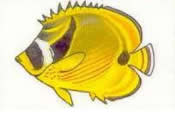 205.9 halfmoon butterflyfish, Chaetodon lunula (Lacepède, 1803). Body yellow or dark brown dorsally, with oblique dark
streaks; black mask over eyes, followed by white band on head and black crescent
on body. Juveniles with black spot on soft D and another on
peduncle. Feeds mainly at night on nudibranchs, tubeworm tentacles, coral
polyps, benthic invertebrates and algae. Does well in aquaria.
Attains 19 cm. Indo-Pacific to
205.9 halfmoon butterflyfish, Chaetodon lunula (Lacepède, 1803). Body yellow or dark brown dorsally, with oblique dark
streaks; black mask over eyes, followed by white band on head and black crescent
on body. Juveniles with black spot on soft D and another on
peduncle. Feeds mainly at night on nudibranchs, tubeworm tentacles, coral
polyps, benthic invertebrates and algae. Does well in aquaria.
Attains 19 cm. Indo-Pacific to East London to just north of Port Alfred, juveniles to Stilbaai, Western Cape.
205.10 pearly butterflyfish, Chaetodon
madagaskariensis Ahl, 1923. Body pearly white, or greyish with 5-7
ragged black chevrons; orange bar from soft D to rear end of A; black eye band
not joined to that of opposite side; U-shaped black mark on nape. Feeds on benthic
invertebrates and algae. Attains 13 cm. Indian Ocean, south to Algoa
Bay.
205.11 doublesash butterflyfish, Chaetodon
marleyi Regan, 1921. Body pearly white, with two broad dark brown (or
orange brown) bands as shown on figure; one or two black ocelli on middle of D;
dark brown band from nape through eye to underside of head. Feeds mainly
on tubeworm tentacles. Attains 20 cm and an age of 4 years. Known
only from Maputo to Western Cape Province.
205.12 blackback butterflyfish, Chaetodon
melannotus Bloch & Schneider, 1801. Body pearly white, with
oblique black streaks running into black area along D base; fins and front of
head yellow; black blotch on C peduncle and (usually) another at base of A
spines. Feeds mainly on soft coral polyps, but adapts well to aquarium.
Attains 15 cm. Red Sea and Indo-Pacific south to Durban.
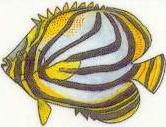 205.13 maypole butterflyfish, Chaetodon meyeri Bloch & Schneider, 1801. Body white, pale bluish or yellow, with
curving black lines; pelvic fins yellow; D & C yellow with black bands; A
black with yellow lines. Feeds only on coral polyps. Attains 17
cm. Indo-Pacific south to Durban.
205.13 maypole butterflyfish, Chaetodon meyeri Bloch & Schneider, 1801. Body white, pale bluish or yellow, with
curving black lines; pelvic fins yellow; D & C yellow with black bands; A
black with yellow lines. Feeds only on coral polyps. Attains 17
cm. Indo-Pacific south to Durban.
205.14 right-angle butterflyfish, Chaetodon trifascialis Quoy & Gaimard, 1825. D & A greenish
yellow, with black-edged white margin. Night (stress) pattern with two pale oval
blotches on body. Feeds only on coral polyps. Attains 17
cm. Red Sea and Indo-Pacific, south to Aliwal Shoal.
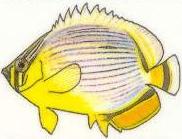 205.15 melon butterflyfish, Chaetodon
trifasciatus Mungo Park, 1797. Head and front of body mostly yellow;
curving dark blue stripes on body make the fish look bloated; A yellow-orange,
with black and white bands along the base. Adults usually in
pairs. Feeds on coral polyps. Attains 15 cm. Indo-Pacific,
south to Kosi Bay.
205.15 melon butterflyfish, Chaetodon
trifasciatus Mungo Park, 1797. Head and front of body mostly yellow;
curving dark blue stripes on body make the fish look bloated; A yellow-orange,
with black and white bands along the base. Adults usually in
pairs. Feeds on coral polyps. Attains 15 cm. Indo-Pacific,
south to Kosi Bay.
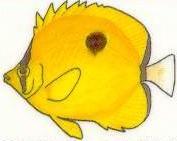 205.16 teardrop butterflyfish, Chaetodon
interruptus Ahl, 1923 [formerly known as C. unimaculatus, which is
confined to the Pacific Ocean and differs in colour]. Head, body and fins
bright yellow; black band through eye; rear edges of D & A with black margin
aligned with black band on C peduncle. Usually seen in pairs; does well in
aquaria. Attains 18 cm. Indonesia to Port Alfred.
205.16 teardrop butterflyfish, Chaetodon
interruptus Ahl, 1923 [formerly known as C. unimaculatus, which is
confined to the Pacific Ocean and differs in colour]. Head, body and fins
bright yellow; black band through eye; rear edges of D & A with black margin
aligned with black band on C peduncle. Usually seen in pairs; does well in
aquaria. Attains 18 cm. Indonesia to Port Alfred.
205.17 vagabond butterflyfish, Chaetodon
vagabundus Linnaeus, 1758. Head and body pearly white, with opposing
series of oblique dark lines; median fins yellow with black bands. Feeds
on anemones, coral polyps, worms and algae, but will take other food in
aquaria. Attains 15 cm. Red Sea and Indo-Pacific to Aliwal;
juveniles to Algoa Bay.
205.18 yellowhead butterflyfish, Chaetodon
xanthocephalus Bennett, 1832. Colour pattern changes considerably with
growth; juveniles have a black eyeband, black spot on C peduncle and black area
covering most of soft D. Occurs singly or in pairs; does well in
aquaria. Attains 20 cm. Sri Lanka to Durban.
205.19 Zanzibar butterflyfish, Chaetodon
zanzibarensis Playfair, 1867. Head, body and fins bright yellow; black
spot on each body scale forming dark horizontal stripes; large black spot on
side; C margin transparent. Feeds on corals; not recommended for the
aquarium. Attains 15 cm. Western Indian Ocean south to
Durban.
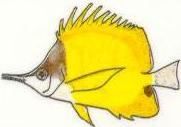 205.20 longnose butterflyfish, Forcipiger
flavissimus Jordan & McGregor, 1896. Body bright yellow; upper part of
head abruptly black, the lower part white; black spot covers last 4-5 A
rays. Feeds on tubeworm tentacles, polychaete worms and small
crustaceans. Attains 16 cm. Red Sea and Indo-Pacific (to Mexico),
south to Margate.
205.20 longnose butterflyfish, Forcipiger
flavissimus Jordan & McGregor, 1896. Body bright yellow; upper part of
head abruptly black, the lower part white; black spot covers last 4-5 A
rays. Feeds on tubeworm tentacles, polychaete worms and small
crustaceans. Attains 16 cm. Red Sea and Indo-Pacific (to Mexico),
south to Margate.
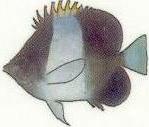 205.21 belted butterflyfish, Hemitaurichthys
zoster (Bennett, 1831). Dark brown with broad white area in middle of
body; C mostly white; D spines over white area are yellow. Seen singly or
in pairs on coral reefs, also in large shoals feeding on zooplankton well above
the bottom. Attains 18 cm. Western Indian Ocean to Aliwal
Shoal.
205.21 belted butterflyfish, Hemitaurichthys
zoster (Bennett, 1831). Dark brown with broad white area in middle of
body; C mostly white; D spines over white area are yellow. Seen singly or
in pairs on coral reefs, also in large shoals feeding on zooplankton well above
the bottom. Attains 18 cm. Western Indian Ocean to Aliwal
Shoal.
205.22 coachman, Heniochus acuminatus (Linnaeus, 1758). Horizontal line at tip of snout extends below eye; snout
longer than eye diameter; black band between eyes not reaching nape. Seen
alone or in pairs near bottom on coral reefs. Often mistaken for
Moorish idol (Zanclus canescens). Attains 25 cm. Indo-West Pacific
to Aliwal Shoal.
205.23 schooling coachman, Heniochus
diphreutes Jordan, 1903. Horizontal line at tip of snout extends
through eye; snout less than eye diameter; black band between eyes reaches
nape. Usually in large schools feeding on zooplankton well above
bottom. Attains 16 cm. Red Sea and Indo-West Pacific south to Aliwal
Shoal; juveniles to Port Edward.
205.24 masked coachman, Heniochus monoceros Cuvier, 1831. Adults with a hump and short spike on nape and short “horn”
in front of each eye; D, A, & C yellow. Adults seen in pairs or small
groups. Attains 23 cm. Indo-West Pacific, south to Aliwal Shoal,
juveniles at Port Edward.
Copyright © 1999 J.L.B. Smith Institute of Ichthyology, Grahamstown, South Africa. Sponsored by Sappi Ltd.